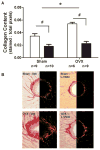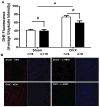Neuronal nitric oxide synthase inhibition improves diastolic function and reduces oxidative stress in ovariectomized mRen2.Lewis rats
- PMID: 21293310
- PMCID: PMC3123430
- DOI: 10.1097/gme.0b013e31820390a2
Neuronal nitric oxide synthase inhibition improves diastolic function and reduces oxidative stress in ovariectomized mRen2.Lewis rats
Abstract
Objective: The loss of estrogen in mRen2.Lewis rats leads to an exacerbation of diastolic dysfunction. Because specific neuronal nitric oxide synthase (nNOS) inhibition reverses renal damage in the same model, we assessed the effects of inhibiting neuronal nitric oxide on diastolic function, left ventricular remodeling, and the components of the cardiac nitric oxide system in ovariectomized (OVX) and sham-operated mRen2.Lewis rats treated with N5-(1-imino-3-butenyl)-L-ornithine (L-VNIO; 0.5 mg/kg per day for 28 d) or vehicle (saline).
Methods: Female mRen2.Lewis rats underwent either bilateral oophorectomy (OVX; n = 15) or sham operation (or surgical procedure) (sham; n = 19) at 4 weeks of age. Beginning at 11 weeks of age, the rats were randomized to receive either L-VNIO or vehicle.
Results: The surgical loss of ovarian hormones, particularly estrogen, led to exacerbated hypertension, impaired myocardial relaxation, diminished diastolic compliance, increased perivascular fibrosis, and increased relative wall thickness. The cardiac tetrahydrobiopterin-to-dihydrobiopterin levels were lower among OVX rats compared with sham-operated rats, and this altered cardiac biopterin profile was associated with enhanced myocardial superoxide production and decreased nitric oxide release. L-VNIO decreased myocardial reactive oxygen species production, increased nitrite concentrations, attenuated cardiac remodeling, and improved diastolic function.
Conclusions: Impaired relaxation, diastolic stiffness, and cardiac remodeling were found among OVX mRen2.Lewis rats. A possible mechanism for this unfavorable cardiac phenotype may have resulted from a deficiency in available tetrahydrobiopterin and subsequent increase in nNOS-derived superoxide and reduction in nitric oxide synthase metabolites within the heart. Selective nNOS inhibition with L-VNIO attenuated cardiac superoxide production and limited remodeling, leading to improved diastolic function in OVX mRen2.Lewis rats.
Figures






References
-
- Lloyd-Jones D, Adams R, Carnethon M, et al. Heart Disease and Stroke Statistics--2009 Update. A Report From the American Heart Association Statistics Committee and Stroke Statistics Subcommittee. Circulation. 2009;119:e21–181. - PubMed
-
- Owan TE, Hodge DO, Herges RM, Jacobsen SJ, Roger VL, Redfield MM. Trends in prevalence and outcome of heart failure with preserved ejection fraction. N Engl J Med. 2006;355:251–9. - PubMed
-
- Roger VL, Weston SA, Redfield MM, et al. Trends in heart failure incidence and survival in a community-based population. JAMA. 2004;292:344–50. - PubMed
-
- Masoudi FA, Havranek EP, Smith G, et al. Gender, age, and heart failure with preserved left ventricular systolic function. J Am Coll Cardiol. 2003;41:217–23. - PubMed
-
- Tsutsui H, Tsuchihashi-Makaya M, Kinugawa S, Goto D, Takeshita A. Clinical characteristics and outcome of hospitalized patients with heart failure in Japan. Circ J. 2006;70(12):1617–23. - PubMed
Publication types
MeSH terms
Substances
Grants and funding
- R37 HL058091/HL/NHLBI NIH HHS/United States
- K08 AG026764/AG/NIA NIH HHS/United States
- R01 AG033727/AG/NIA NIH HHS/United States
- R01 GM077352/GM/NIGMS NIH HHS/United States
- R01 HL056973/HL/NHLBI NIH HHS/United States
- R29 HL056973/HL/NHLBI NIH HHS/United States
- HL-56973/HL/NHLBI NIH HHS/United States
- R29 HL058091/HL/NHLBI NIH HHS/United States
- R01-AG033727-01/AG/NIA NIH HHS/United States
- R01 HL058091/HL/NHLBI NIH HHS/United States
- HL058091/HL/NHLBI NIH HHS/United States
- K08-AG026764-05/AG/NIA NIH HHS/United States
LinkOut - more resources
Full Text Sources

